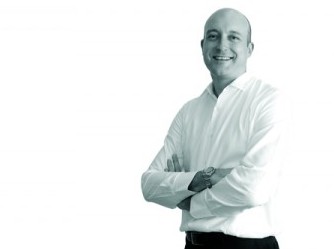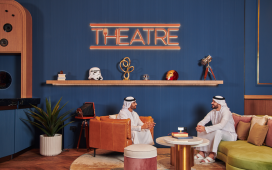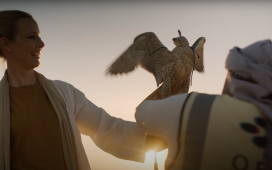The agency claims growth of 19 per cent in 2014, with social and content being the fastest growing. ‘Non-media’ revenue is expected to touch 8 to 9 pc of the total in 2015, up from 5 pc last year.
How was the last year for UM MENA? And how has it been for you, moving from Hong Kong (Apac)?
UM is in an interesting position in this region. Globally, we perhaps haven’t done as well as we would have liked over the last couple of years. Losses like Mastercard and Microsoft were disappointing. But in this region, we are in a slightly different position.
Syria (ops) has been closed down for obvious reasons. We do have an affiliate in Yemen, which is also not really operative at the moment. Pretty much everywhere else, we have a structure of fully owned offices, which is different from the hub model (followed by some other agencies). Which is why, I spend quite a bit of time traveling to other offices. To be honest, it is quite difficult to get the culture consistent across all markets. But the one thing that helps us is that client portfolio.
We handle Coca-Cola across the region and North Africa and we also handle L’oreal. We had the L’oreal pitch when I first came in. It was great to retain it, because that’s a business everyone wants to win. Sometimes, winning a pitch to retain a business is more stressful, because you can tend to focus too much on the negative side of things. If you are pitching for something new and don’t win, you don’t need to make all those cost adjustments.
Those two pieces of business really help drive the company and the culture. Without having that consistency in clients, it is difficult to bind those offices together. From the management point of view, it helps show the direction in which we are going.
What is the Big ‘Boutique’ philosophy and how does this help? How is social integrated with planning?
The vision is to build the best company in the world. Behind that is the ‘Big Boutique’ philosophy, and a company built on the five pillars of people, product, performance, pitching and planning. Yes, we are a global agency and we have all the things that a global agency comes with, but we needed to take a more tailored approach towards our clients. So when we work with different kinds of clients we have different structures and different models in place.
The real principle behind it is to make sure that for each client, we give them a competitive advantage. The competitive advantage could be in any aspect of our offering.
The difference that we provide clients vis a vis our competitors is marginal. There’s no silver bullet that makes our offering 10 times better. It’s a portfolio of things.
The second part of it is what we introduced at the beginning of last year – ‘Social at heart’. We’re talking about using social media at different levels. Historically, we planned using a variety of data sources – from Ipsos to our own studies to monitored spends and others.
So if you are our client, regardless of whether you are using another agency for social media, social media thinking will be embedded into the planning at an early stage.
Every employee in every UM MENA office has access to social data on the desktop. If we want to understand about, say, Sony, we can understand what people are saying about it in real time. The technology exists; how we embed it in the planning process is a little bit new.
At the next level, we offer social media services. We have UM Society, our full service social media offering. There are aspects like community management, listening, analytics, design and a real time studio.
We have about 10 to 12 clients for this, ranging from Coca-Cola to Sun and Sand and Mentos. My philosophy is that social is part of our core competency. Where we differentiate is not just through real time content, but also synergising with our real time media activity.
Television is still the de facto position for large FMCG companies and many other clients in this region, and will be for a long period of time. So if you are sponsoring or advertising on a large property like Arab Idol or Coke Studio, how do you synergise content and social activity at the same time? That’s how we go to the market with the offering.
Where we differ from a PR agency or a creative agency is that we look at synergising it in a different way. Where a PR agency would look at it more in terms of content, and a creative agency in terms of the big idea, we look at it more holistically. I started with that model in Hong Kong three years ago.
When we do pitches for social media, clients aren’t looking at it as one media agency versus another. In some large pitches, we are up against social specialists, PR agencies or creative agencies. The model we have may not be right for every client, but it’s a much more interesting area for us.
Literally, everyday, for the last three years, we have been trying to get new people in (for social, content). Talent is a challenge. We have a great team in place now. But every time we think we’ve got everyone we need, we find the need to expand.
The real piece I want to take ownership of, is local insights and analytics on social media. Rather than doing it with a combination of expatriates and people from here, we’d like to do it with locals in certain key markets.
Apac versus MENA as media markets – how similar or different are they? Apart from there being measurement challenges in MENA?
Measurement is an issue in Asia as well. When I went to China about 10 years ago, we were relying on various data sources, which really inhibited clients. There was a mixture of diary data and Peoplemeter data. In the last 10 years I think it has moved to reasonably credible Peoplemeter data, which has helped accelerate the advertising market.
The other similarity is in the pace of things – in terms of the emerging new technologies and the pace of growth.
The big difference to me would be that the opportunity in MENA is very different. This (region) is much more homogenised in terms of language. So it gives you the power to come up with core central ideas that can transcend across the region. The language and the culture here are relatively similar. You obviously need to have the local insights, nuances in language, but relative to a geography like Asia Pacific, the MENA region is more homogenised.
The other thing is, certainly Dubai and UAE anyway, this region is a much more diverse mixture of people. In the Asia Pacific, it’s a little bit more local. There are expats, but the diversity is not that high.
In Dubai, UM is about 120 people. I think we must have about 30 different nationalities. Across the region, we would have over 400 people.
Has lack of robust TV measurement affected investments?
The truth is that inside information is key. Not having a real picture of what’s happening, despite the cross checks we have with all the data that is available, is actually going to affect the industry.
Ad expenditure as a percentage of GDP is very less in this part of the world. You start questioning why. As the industry matures, it needs to have better data points, not just on TV but across media. The better the data, the more the ad market will grow.
Tell us about the revenue buckets for UM MENA and how they stack up. Media would still be the largest, by far?
Media is still the largest, but it is changing. In terms of absolute size, media has been the biggest for a number of years. In the last 14 or 15 months, the big growth area has been social – where we are seeing triple digit growth. This year, we should end up with 8 to 9 per cent of revenue from data, mobile and content (from over 5 per cent in 2014). That is pretty huge.
Across MENA, social would be about 35 people, with half of them in Dubai.
Are revenues keeping pace with digital/mobile consumption?
No, but that’s true anywhere in the world. That’s actually another similarity with other markets in Asia. Technology has jumped certain steps, in social and mobile in particular. You have gone from not even having a sophisticated multi-channel television market to having these new platforms.
To answer that question, if you look at time spent, engagement and other parameters, then yes, the ad dollars are very low. There are reasons for that. One, it is much more challenging to make effective campaigns (online). And the results are less certain – they are much more unpredictable. Number three: clients and agencies are not geared up; there is a legacy of ‘this is how we do things’. Anywhere in the world, there is a legacy of doing the TV commercial first.
I made this presentation recently, in which I spoke about the different phases of media. The first was all about impact… buying impressions, buying TV – that was about 20 years ago. Next came the connected phase, when it was pretty much about engagement.
The challenge for all of us is that in those kind of (connected) mediums, what is the value exchange for the consumer that advertising is bringing? What is the benefit or engagement or enjoyment that advertising is bringing them?
If you look at the 1960s, people were happy to watch free TV and watching the advertising that came with it. The advertising was funny and engaging. They still don’t mind doing that. But in the technically, consumer-enabled platforms, you can’t expect them to watch it because there is no value to watching it. So the challenge for everyone is how we can make the time spent really engaging and a valuable experience for the brand and the consumer.
If you look at the campaigns that are going around the world, like the Ice Bucket Challenge, which was really advertising for charity… people shared it. It’s engaging content. The challenge for mobile, for Facebook, for anything social is to create engaging content. People need to have a little different set up to deliver that.
Till you can produce consistently different and engaging content, the ad dollars will not follow. That’s really the challenge for everyone, and more for creative agencies. You have to create engaging content everyday. How can you create 300 pieces of engaging content through the year?
How does one go about real time content based on social listening? Is it feasible on an ongoing basis?
It can be done. Let’s say we want to sell a travel package to Europe on an airline. We can go out and figure people interested in the destinations, and see their conversations. If there is a TV show that’s relevant, we can see what conversations people are having around it. It’s easier then for us to connect the two pieces together and build a piece of content around it.
We know that on Friday, two million people are going to be watching a programme and one million are going to be talking about it on social media. If we put those insights together, then you can do it. That’s why the studio has to be real time.
Oreo was great stuff. But we’re looking at more consistent, prosaic stuff. We know TV programming, we know what’s coming and also, we know how to leverage content from the owners. We know who is brilliant at producing content; we also have our own content.
It’s basically about having a plan. It isn’t as simple as it sounds and it doesn’t turn out the way you expect it to. It’s fluid. And that’s what I love about social media listening.
Are specialists like UM Content housed within UM?
We’re not going down this route of setting up different specialist companies. I think that’s the wrong model for us; it may not be wrong for everybody. We’re setting up specialist skills integrated within our planning teams.
As a product, we should be able to deliver an integrated solution that isn’t dependent on one company or unit. The people in UM Social tend to be more specialist in social, but everyone within UM will be equipped to offer social as part of a solution.
This explains the branding, where it’s still a ‘UM’ Content. There was a time when agencies used to create different units for the sake of being able to bill clients independently. The market has moved on. Now we can tell clients that we won’t be able to offer these specialised additional services on the back of a 3 per cent commission (on media).
Is the non-media part of the business more profitable?
It’s good to be revenue-diverse. Is it more profitable? I don’t think it is in this part of the world, at this point in time.
You have a higher investment cost. The volumes are simply not there. And you’re riding on the existing infrastructure.
The way we are looking at it, it is an essential part of the integrated offering – not as a standalone unit.
Do you see programmatic buying taking off?
Programmatic here is probably a year or two behind North America and Western Europe, in terms of client understanding and acceptance. That will come in as it has everywhere in the world.
Programmatic is not just about the efficiencies you can generate in terms of behavioural targeting but also about the content – about what message you want to put out. What has tended to happen is that programmatic has been used to reduce cost.
What was the overall growth in 2014 and what are you foreseeing for 2015?
Our billings grew at around 19 per cent last year. I expect growth next year, except that it may not be as high as 19 per cent – there is too much uncertainty coming into 2015. Last year, we had high growth, and expanded on the client base and the services on offer.
In terms of social media and content, it was proba-bly about 130 per cent growth. I expect the non-media parts of the business to grow probably at 200 per cent, albeit on a smaller base.
From a macro perspective, you always worry about the oil situation for GCC. Unlike anywhere else in the world, when the oil price is low here, it’s not ideal. KSA is such an important market in the GCC. I think it’s going to be an interesting quarter.
Egypt is a massive market. It has seen three to four years of political turmoil. Maybe this year we will see a bit more stability.
So, given the economic uncertainty in GCC and political uncertainty in Egypt (and some other markets), I don’t think things will be as good as they were in 2014.
I would say in 2014, the industry grew at 4 to 5 per cent. If we had had this conversation 12 months ago, I would have predicted 8 or 9 per cent. The last six months of the year were much slower than the first six. We expect that trend to go into 2015.
(A shorter version of this interview appears in the issue of Campaign Middle East dated 22 February 2015.)










